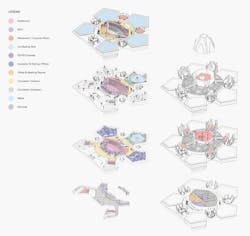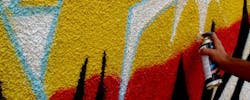Graffiti Resistance: Protecting Your Buildings in a Safer Way
According to the U.S. Department of Justice, an estimated $12 billion per year is spent on removing graffiti-based vandalism. For some, graffiti is a problem that isn’t disappearing, and this type of vandalism can take away from the aesthetics of a building, potentially making visitors feel unsafe. It can also hurt property values, bringing them down 15 to 30 percent if graffiti is present on a building.
Traditional methods of removal include using harsh chemicals or pressure washing to eliminate graffiti from surfaces, which could damage the building or surface underneath.
In 2015, Valspar aligned with Graffiti Removal Services (GRS) to provide a solution that is environmentally friendly, non-toxic to the user, and, most importantly, does not harm the substrate. No additional prep is needed to utilize the cleaning solution, which specifically targets the thin layer of pen, marker, crayon, boat polish, or other materials that may have been used to vandalize the area. The product encapsulates the graffiti, dissolves it, and the user wipes the residue off with a damp towel or rag.
Paul Watts, founder and CEO of GRS, spends one week a month traveling to various cities and municipalities, providing training on how to safely and effectively remove vandalism without damaging the environment or substrate.
“Some buildings that are vandalized are older, which means the surface can easily be damaged if the wrong removal materials are used,” Watts explains. “Once you remove it, after a week or so it has a high probability of re-appearing. By training city and facility workers I can explain that the best deterrent to getting graffiti out of your neighborhood is a quick response and quick removal.”
Rapid removal of graffiti, removing it 24 to 48 hours after the incident, not only helps with decreasing lasting damage, but may also be part of a state’s jurisdiction.
In Portland, Ore., where Watt’s company is located, graffiti must be removed within 24 hours. Because of stringent guidelines being set about graffiti removal in some areas, customers began to ask for a removal system that would be quick, effortless, and not invasive to the environment.
The response: a non-damaging product that uses no wastewater, is biodegradable, non-toxic, and VOC-compliant. It also meets ASTM standards in graffiti resistance—meaning that graffiti can be successfully removed without harming the building or surface that has been vandalized.
Each item that comprises the Valspar architectural exterior metal coating has gone through testing within the ASTM standard to ensure that the final product will not harm the environment years after it’s been applied, and that the solution will have no long-term effects on the coating.
Valspar offers its customers this resource to remove graffiti off their panels without adding any bottom line to the cost. When a customer orders a product through GRS, the company supplies training videos and catalogs to walk them through the removal process.
No building is completely safe from graffiti, but the alignment between Valspar’s coil and extrusions coatings and GRS’ cleaning solution provides a successful graffiti removal method without damage to the original substrate, the environment, or the user.

